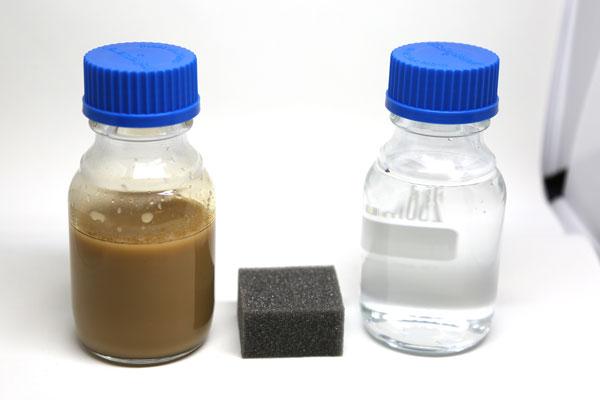December 17, 2019 | Research
U of T researchers develop sponge that removes oil from water
By Tyler Irving

Designed to clean oil from industrial wastewater, U of T researchers are exploring whether sponge technology developed by PhD student Pavani Cherukupally (MEng 2014, PhD 2019) can be adapted to help clean up marine and other spills (photo by Kevin Soobrian)
University of Toronto researchers have developed a new strategy to remove tiny oil droplets from wastewater with more than 90 per cent efficiency in just 10 minutes. Their secret weapon?
A sponge.
“Oil extraction operations such as hydraulic fracturing, or fracking, produce nearly 100 billion barrels of oil-contaminated wastewater each year,” says Chul Park, a professor in the department of mechanical and industrial engineering in the Faculty of Applied Science & Engineering.
“Because the oil is in the form of tiny droplets rather than a large oil slick, we can’t use the same strategies we would use to clean up a surface spill.”
Park’s graduate student, Pavani Cherukupally (MEng 2014, PhD 2019), took up the challenge. She drew on Park’s expertise in microcellular foams, as well as the water technology experience of her co-supervisor Assistant Professor Amy Bilton (BASc 2004).
Cherukupally focused on the use of ordinary polyurethane foams – similar to those found in couch cushions – to separate tiny droplets of oil from wastewater. By carefully controlling the porosity and other properties, she designed sponges that would adsorb – or hold on its surface – oil droplets while letting water flow through efficiently. Two years ago, she reported a prototype that could remove more than 95 per cent of the oil in the samples she tested.

But there were two major drawbacks to this system. The first was a slow rate of removal. It took three hours to remove oil droplets from water, which would not be fast enough for an industrial-scale process.
The other had to do with the pH of the water.
“The optimal pH for our system was 5.6, but real-life wastewater can range in pH from around four to 10,” says Cherukupally. “As we got toward the top of that scale, we saw removal drop off significantly, down to maybe six or seven per cent.”
Both sponge and oil can be recycled and reused
In her latest work, published today in the journal Nature Sustainability, Cherukupally partnered with U of T chemists Wei Sun and Annabelle Wong (MSc 2017) in the lab of Geoffrey Ozin, a professor in the department of chemistry in the Faculty of Arts & Science, to chemically modify the foams. By adding tiny particles of a material known as nanocrystalline silicon to the foam’s surface, they were able to control its critical surface energy.
“The critical surface energy concept comes from the world of biofouling research – trying to prevent microorganisms from attaching to surfaces such as the hulls of ships,” says Cherukupally.
“Normally, you want to keep critical surface energy in a certain range to prevent attachment, but in our case we are manipulating it to promote attachment of oil droplets.”

Cherukupally also reached out to Professor Daryl Williams at Imperial College London. His lab group provided specialized surface characterization techniques to validate the team’s approach to controlling the critical surface energy, as well as advice on oil recovery. Cherukupally continues to work in his lab as a post-doctoral researcher.
The current prototype works over a much wider pH range than the previous version. It’s also faster. At pH 5.6, the system removes more than 92 per cent of the oil in just 10 minutes. The oil is easy to extract using common solvents, enabling it to be recovered for use. The sponge can be also be re-used – the team tested it 10 times and saw no degradation in performance.
The team is working with the Canadian government on scaling up the system to clean up marine oil spills
The work has spawned two new collaborations. The first, between Park and researchers at Natural Resources Canada, looks at scaling up the system and adapting it for salt water to clean up marine oil spills. The other, between Bilton and Fisheries and Oceans Canada, focuses more specifically on marine spills in low-temperature environments, where changes to oil’s viscosity makes it even more difficult to remove.
“Current strategies for oil spill cleanup are focused on the floating oil slick, but they miss the microdroplets that form in the water column,” says Bilton. “Though our system was designed for industrial wastewater, adapting it for freshwater or marine conditions could help reduce environmental contamination from future spills.”
The research was supported by the Natural Sciences and Engineering Research Council of Canada and Fisheries and Oceans Canada, among others.

